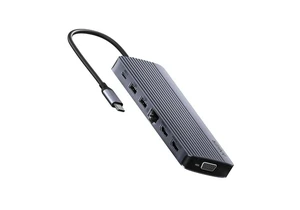Roku is still going strong with its smart home efforts, revealing on Wednesday a pair of new battery-powered smart cameras that are designed to weather the elements. More notably, Roku is flying solo with its latest security cams rather than partnering up with a third party.
While Roku had previously worked with Wyze Labs on its earlier smart home products, the upcoming Roku Battery Camera and Roku Battery Camera Plus are “all specifically Roku-designed cameras,” a Roku spokesperson told me during a New York City press event. (The company also unwrapped new Roku streaming players, which you can read about here.)
Asked for the strategy behind breaking with Wyze, the Roku rep explained that the move allows for “more control over the app and the experience and prioritizing what we want to do, versus Wyze.”
Reached later by TechHive, another Roku spokesperson offered an additional statement: “We’re glad to have worked with Wyze to initially bring Roku Smart Home to the market. We’re proud of our new Roku-designed Battery Camera and Battery Camera Plus and excited to bring it to our Roku users.”
We’ve also asked Wyze for more details.
Previously known solely as a streaming media device manufacturer, Roku surprised many in the industry with its 2022 announcement that it was moving into the smart home space.

The Roku Battery Camera and Battery Camera Plus both have a bottom USB-C charging port.
Ben Patterson/Foundry
The company did so with the help of Wyze, the maker of a popular line of budget security cameras as well as other smart home products. Roku ended up white-labeling a number of Wyze products, including smart light bulbs and light strips, smart plugs, video doorbells, and—naturally—security cameras.
Roku later released the Roku Home Monitoring System SE, a rebrand of the Wyze Home Monitoring Core Starter Kit, and it also sells an indoor 360-degree camera, an outdoor camera, and a floodlight cam.
The new Roku Battery Camera and Battery Camera Plus look very different from the company’s Wyze-developed products. Both of the 1080p cams sport boxy, rectangular shells with rounded corners. They offer IP65-level protection from dust and resistance to low-pressure water jets from any angle. Rear threaded mounting holes let you attach the cameras to walls, eaves, or other structures.

A rear threaded hole allows for mounting to a wall, eave, or other structure.
Ben Patterson/Foundry
The main difference between the two new Roku cams appears to be their battery life, with the Roku Battery Camera ($49) delivering up to six months of battery-powered operation, versus up to two years for the Battery Camera Plus ($59). An upcoming and optional solar panel (no pricing yet) should allow the cameras to run almost indefinitely without the need for manual charging via AC adapter.
Other features on the new cameras include an integrated spotlight, two-way audio, and motion alerts. Person, package, vehicle, and pet detection features require a Roku home security plan, which starts at $3.99 a month for a single camera (a second cam costs an additional $3.99 per month), or $9.99/month for all your cameras.
As with previous Roku security cameras, the Roku Battery Camera and Battery Camera Plus boast tight integration with the Roku app as well as Roku streaming players, with the latter capable of showing live feeds in a carousel on your big-screen TV.
Expect the Roku Battery Camera and Roku Battery Camera Plus to arrive this summer. We’ll have full reviews once we have a chance to test out some sample units, so stay tuned for that.
https://www.pcworld.com/article/2761236/roku-goes-it-alone-with-its-latest-security-cameras.html
Войдите, чтобы добавить комментарий
Другие сообщения в этой группе

Lorex is now shipping a new Wi-Fi pan/tilt security camera with an in

A virtual private network, aka VPN, is one of the best tools you can

Roku is going small with its latest streaming players, unveiling a ne

If you’re using an Android phone, you’ve probably noticed that Google

Tired of having to switch between tabs when you have a YouTube video


In order for laptops to get slimmer and lighter, they’ve had to make
